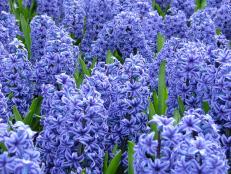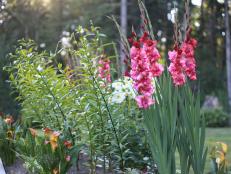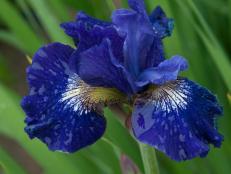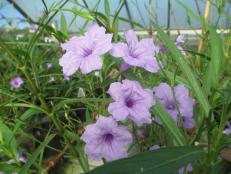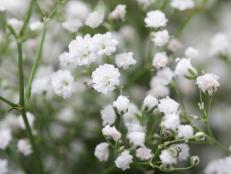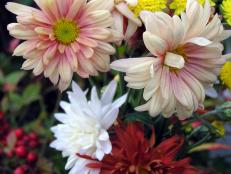Crinum
Plant type: Perennial bulb
Hardiness: USDA Zones 8 to 11 (some species are slightly hardier)
Also known as crinum lilies and spider lilies, these beauties have long been favorites in the southern states, but gardeners in many other areas can enjoy them as well. The giant-sized bulbs send up long, strap-like, deciduous to evergreen leaves and separate stout stalks topped with clusters of large, trumpet-shaped blooms. Usually white or pink and often fragrant, crinum flowers are typically in the two- to four-foot-tall range and bloom at varying times during the growing season, depending on the species.
How to use them: Where the bulbs are dependably hardy, grow crinums in single clumps or in mass in garden borders, foundation plantings or planters. Elsewhere, container growing is probably your best option, because crinums seem to dislike being dug up each year for indoor storage and may refuse to bloom for a year or two after replanting. Keeping them in a pot makes it possible to haul them indoors for the winter without disturbing their roots. Crinums' pale blooms and exceptional scent make them a must-have for evening gardens, and they make great cutflowers too.
Culture: Full sun is usually best for crinums, although they can take partial shade as well; afternoon shade is often ideal in hot climates. Evenly moist but well-drained, humus-rich soil encourages lush growth and most abundant bloom, but average garden soil can also produce fine results. Plant crinums with the tips of their bulbs just above the soil surface. Water and fertilize potted crinums regularly during the growing season, then keep them on the dry side during the winter. Indoors, they like a bright but relatively cool spot. Wait until all danger of frost has passed to set them outside again in spring. In sheltered spots, crinums planted in the ground may survive the winter a zone or two north of their usual range, especially if you protect them with a thick layer of coarse mulch. If you want to propagate your crinums, divide the clumps in spring; otherwise, just leave them alone. No serious pest or disease problems.
Special notes: Crinums are among the most fuss-free garden flowers around and are seldom bothered by pests. The bulbs of some species are poisonous if ingested, and touching the sap may irritate sensitive skin.
Selected species







